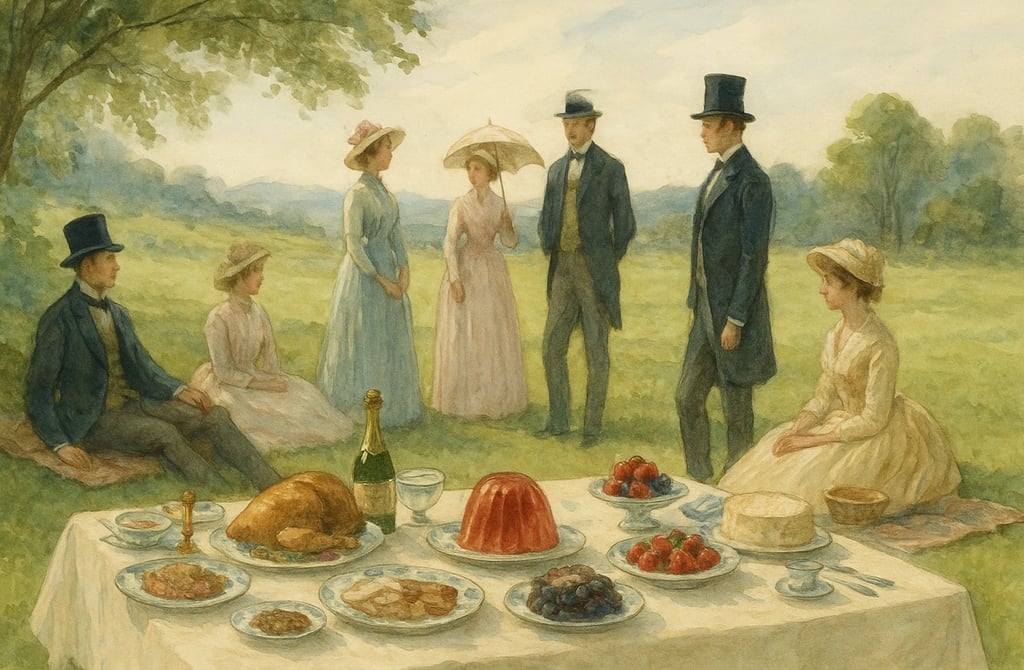Victorian Picnic Traditions: How the Victorians Dined Like Royalty
Discover Victorian picnic traditions — opulent outdoor feasts with champagne, jellies, and live music that turned nature into a grand 19th century dining room.
FOOD HISTORY & TRADITIONS


At Hida Dream Home, we love the slow rituals of the past — those moments when eating, gathering, and celebrating were treated as art. And in the 19th century, no one elevated the humble picnic quite like the Victorians.
Forget sandwiches hastily wrapped in paper or lukewarm lemonade. A proper Victorian picnic was a banquet under the trees, where nature became a grand dining room and every detail spoke of elegance. Across manicured lawns or tucked into the countryside, carriages would roll in with wicker hampers not just of food, but of china, silverware, and linen. For the wealthiest hosts, servants accompanied the party to set tables, pour drinks, and keep everything as seamless as if they were dining indoors.
The menu? It was nothing short of indulgent. Entire roasted chickens and cold game pies sat alongside platters of charcuterie, cheeses, and delicate pastries. Bowls of fresh berries, sponge cakes layered with cream, and ornate, jewel-toned jellies trembled like stained glass in the sunlight. Champagne flowed freely, kept cold in silver buckets, while tea was brewed over small burners and poured from porcelain pots — even in the middle of a meadow. A Victorian picnic was never about roughing it; it was about transporting every comfort of the drawing room into the fresh air.
Beyond the food, these events were social theatre. Picnics offered a rare opportunity for men and women to mingle more freely than in formal dining rooms, with lawn games, quiet walks, and even music shaping the day. Ladies in flowing pastel gowns carried parasols as they strolled the grounds; gentlemen in crisp coats lounged on rugs or in wicker chairs. These weren’t hurried meals, but languid afternoons designed for conversation, flirting, and being seen.
For the upper classes, every detail was curated to impress. The wicker hampers themselves were often custom-made, with compartments for glassware, utensils, plates, and even decanters. Some families travelled with collapsible furniture so no one had to sit on the grass. And for hosts eager to make an impression, live entertainment was part of the package — string quartets playing beneath the trees, or even a small portable piano to provide a soundtrack for dancing and song.
Fun fact: Some of the most extravagant Victorian picnics rivalled indoor banquets. One gathering in the 1880s hosted over 200 guests, with multiple courses, liveried waiters, and a full orchestra playing beneath a marquee as guests dined on lobster, champagne, and elaborate desserts.
These grand affairs soon trickled down to the growing Victorian middle class. While they couldn’t match the scale of the aristocratic spreads, many middle-class families adopted their own version of the picnic — homemade pastries, cold meats, and fresh fruit shared on a simple blanket. The essence of the ritual remained: food was beautifully prepared, time slowed down, and the meal became an occasion rather than a necessity.
Victorian picnics remind us of something we often forget: that food and beauty were once inseparable. Meals weren’t rushed or pared down; they were invitations to linger. Even outdoors, there was a sense of ceremony — a belief that dining, no matter the setting, could be art.
So, the next time you pack a basket for the garden or countryside, consider borrowing from this era. Lay a proper cloth, pour drinks into real glasses, and bring along something homemade — even if it’s just a simple cake. A picnic can be more than a quick meal; it can be a small ritual of joy, a way to slow the world down and let nature become your dining room.
